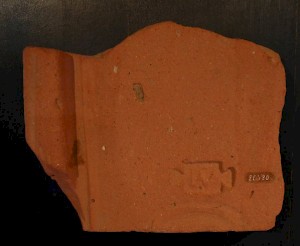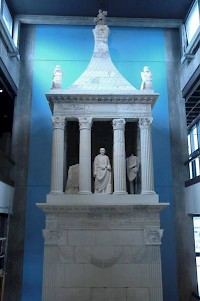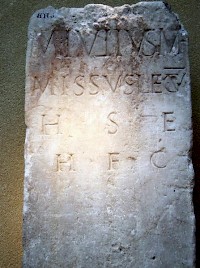Legio V Alaudae
Legio V Alaudae: one of the Roman legions. Its name, which is not Latin but Gaulish, means "the larks" (cf. French alouette).

This legion was founded in transalpine Gaul in 52 BCE by Julius Caesar. It was the first legion to be recruited in the subject provinces, and Caesar paid the soldiers from his private purse. Only later was it recognized by the Senate. The creation of this unit was an important step towards the romanization of the provinces: from now on, the provincials were no longer barred from service in the legions.
Maybe the legion was originally called V Gallica. The unusual, Gaulish surname must refer to the Gallic custom to wear lark's wings on their helmets (still visible on the boxes of Gauloise cigarettes). The new legion saw its first action during the campaign against the Gallic leader Vercingetorix and the siege of Alesia.
During the civil war between Caesar and his fellow-triumvir and rival Pompey, V Alaudae took part in Caesar's invasion of Italy (49) and stayed in Apulia for some time. In the winter of 49/48, it served at Dyrrhachium, after Caesar's assistant Mark Antony had ferried it across the Adriatic Sea. It was not present when Caesar defeated Pompey in the battle of Pharsalus.
However, it did take part in the African campaign against Scipio and Cato (46), which culminated in the battle of Thapsus. Here, the legion heroically fought against the elephants used by Caesar's republican enemies. This made great impression, and V Alaudae is the only Caesarian legion known not to have used the bull as its emblem. Instead, it chose the elephant.
The Fifth was also present at Munda (17 March 45).
After the violent death of the legion's founder on 15 March 44, civil war broke out between Caesar's adjutant Mark Antony and his adopted son Octavian. Both wanted to be leader of the Caesarian faction. The fifth legion sided with Antony and fought for him in the lost battle of Mutina (43) against Octavian. When the two men later decided to cooperate (Second Triumvirate), they defeated the murderers of Caesar in the battle of Philippi (42). Again, V Alaudae was there.

Later, it followed Antony to the east, where veterans were settled at Berytus. The Fifth must have participated in Antony's ill-fated war against the Parthian empire. It is interesting to notice that one soldier, known from an inscription, was called Gaius Valerius Arsaces - an unexplained Parthian surname. Antony employed the fifth legion also during his campaign against Octavian, which culminated in the naval battle off Actium (31).
Here, Antony was defeated. The victor, now called Augustus, transferred the Fifth to Mérida in Lusitania after 30 BCE, where it took part in the campaigns against the Cantabrians, which started in 25. (It may be noticed that Mérida started to strike coins with lark's wings.) The Cantabrian war was one of the largest wars Rome ever fought: among the troops involved were I Germanica, II Augusta, IIII Macedonica, V Alaudae, VI Victrix, VIIII Hispana, X Gemina, XX Valeria Victrix, and another legion, perhaps VIII Augusta.
After a few years, V Alaudae was moved to Gallia Belgica, where it (temporary) lost its standard, when its commander Marcus Lollius was defeated by the Germanic Sugambri (17/16; clades Lolliani). The battle probably took place in the valley of the Meuse. Although we cannot be precise, it is likely that the transfer from Hispania Ulterior to Belgica had taken place in 19, when Augustus' friend Marcus Vipsanius Agrippa invaded Germania.

The fifth legion was transferred to Nijmegen or Xanten by Augustus' stepson Drusus and it took part in his Germanic campaigns. The soldiers of V Alaudae crossed the Weser and reached the Elbe in 9 BCE. For some time, they may have lived at Oberaden or Haltern on the east bank of the Rhine.
In 6 CE, Augustus' son-in-law Tiberius was to lead at least eight legions (VIII Augusta from Pannonia, XV Apollinaris and XX Valeria Victrix from Illyricum, XXI Rapax from Raetia, XIII Gemina, XIV Gemina and XVI Gallica from Germania Superior and an unknown unit) against king Maroboduus of the Marcomanni in Czechia; at the same time, I Germanica, V Alaudae, XVII, XVIII and XIX were to move against Czechia as well, attacking it along the Elbe. It was to be the most grandiose operation that was ever conducted by a Roman army, but a rebellion in Pannonia obstructed its execution.

Not much later, the battle in the Teutoburg Forest (September 9 CE) put an end to what hopes the Romans may have had to conquer Germania. Commander Lucius Nonius Asprenas used the First legion Germanica and the Fifth legion Alaudae to occupy the fortresses of Germania Inferior and prevent a Germanic raid on Belgica.
After the disaster, V Alaudae was stationed at Xanten, together with XXI Rapax, keeping an eye on the nearby tribe of the Cugerni and guarding the confluence of the Rhine and Lippe. Both units took part in the Germanic campaigns of Germanicus in the first years of the reign of Tiberius (14-16). In 43, the twenty-first was replaced by XV Primigenia. At the same time, Xanten was rebuilt. We know that the Fifteenth occupied the eastern half of the base, and the Fifth the western.
In 28 CE, the fifth legion suppressed a Frisian revolt (text), but the emperor Tiberius nonetheless allowed the Frisians to be independent. Twelve years later, V Alaudae joined the emperor Caligula when he visited the delta of the Rhine. The famous anecdote, told by Suetonius, about the emperor commanding soldiers to collect shells on the beach, refers to the visit of the fifth to Lugdunum (Katwijk).

V Alaudae and XV Primigenia must have been part of the expeditionary force that was led against the Frisians and Chauci by the Roman general Gnaeus Domitius Corbulo in 47. The operation was very successful, but the emperor Claudius ordered the Romans to keep the Rhine as the empire's frontier. The soldiers were now ordered to build fortifications along the Rhine and dig a canal from Matilo (Leiden) to the capital of the Cananefates, Voorburg. Corbulo's canal still exists.
Another non-military activity was the production of tiles. Every legion owned and operated a tilery. It is odd to notice that V Alaudae made these objects at Feldkassel, more than 90 kilometers away.
In 67, the position of the emperor Nero became untenable: many senators were discontent and several governors discussed his removal. Among these were Lucius Clodius Macer of Africa (who recruited the I Macriana Liberatrix) and Gaius Julius Vindex of one of the provinces in Gaul, who supported the governor of Hispania Tarraconensis, Servius Sulpicius Galba, when he proclaimed that he wanted to dethrone Nero.

This was treason, and the army of Germania Inferior (I Germanica, V Alaudae, XV Primigenia and XVI Gallica) knew what it had to do: it marched to the south and defeated Gaius Julius Vindex. The soldiers expected to be rewarded, but were disappointed: Galba and a newly recruited Seventh Legion marched on Rome, the Senate recognized him, and Nero committed suicide (June 68). What had been exemplary behavior, was now explained as an attempt to obstruct the accession of the new emperor.
Therefore, the army of Germania Inferior acclaimed their own commander, Vitellius, as emperor, and marched on Rome (January 69). They were successful, and Vitellius started his reign. However, in the east, general Vespasian had also decided to make a bid for power; the two armies clashed near Cremona in northern Italy, and the Rhine army turned out to be no match for the soldiers of Vespasian.
Meanwhile, in Germania Inferior, a disaster was in the making. The Batavians felt offended because Galba had dismissed his Batavian bodyguard, and revolted. A Roman expeditionary force, consisting of the remains of V Alaudae and XV Primigenia, was defeated near Nijmegen, and not much later, these two legions found themselves besieged at Xanten. Although I Germanica, XVI Gallica and a legion from Germania Superior, XXII Primigenia, tried to rescue them, the two legions at Xanten were forced to surrender in March 70. Not much later, I Germanica and XVI Gallica surrendered as well.
It took several months before the new emperor Vespasian could send a strong Roman army to recover the Rhineland and suppress the Batavian revolt, commanded by his relative Quintus Petillius Cerialis. The legions XVI Gallica and IIII Macedonica, which had guarded Mainz, were renamed (XVI Flavia Firma and IIII Flavia Felix); the remains of I Germanica were added with Galba's Seventh legion and became known as VII Gemina ("the twin legion"). XV Primigenia and V Alaudae were never reconstituted.
Literature
- T. Franke, "Legio V Alaudae", in: Yann Le Bohec, Les légions de Rome sous le Haut-Empire (2000 Lyon) 39-48
- K. Strobel, "Die Legio V Alaudae in Moesien" in: Historia 37 (1988) 504-508
- article by Emil Ritterling.